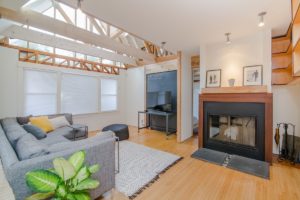- Ensure the air quality indoors is safe by using low-VOC paints and increasing ventilation via windows, doors, and exhaust fans.
- Maintain cleanliness levels by regularly sweeping, mopping, and vacuuming; wash bedding and other fabric items as well.
- Select furniture with smooth edges that conform to safety standards; look for sturdy pieces with locking mechanisms.
- Inspect electrical outlets for potential hazards; contact a professional electrician if unsure of safety.
Becoming a parent is filled with moments of love and joy. However, you are also responsible for ensuring your children are kept safe. The most meaningful way to show them how much they mean to you is by establishing a secure home for them to grow up in.
But with so many areas of safety to consider, how do you start the process? Here are a few crucial steps to creating a safe home environment for your children.
Indoor Air Quality
One of the most important aspects of maintaining a healthy home for children is keeping indoor air quality at an acceptable level. Keeping the air in your home clean can be challenging due to traffic, dust, pet dander, bacteria, etc., but thankfully you can take steps to reduce these contaminants.

Interior Home Painting
If you’re thinking about repainting any of the rooms in your house, it’s crucial that you use only low-VOC paints, which contain fewer volatile organic compounds (VOCs) than standard paints. VOCs can cause health problems such as headaches and respiratory issues, so using these paints will help improve the air quality inside your home. If possible, choose water-based paints as they emit fewer pollutants into the air than their oil-based counterparts.
However, if you’re unsure which products to use, consult a professional familiar with health-safe home interior painting. These are experts who will be able to guide you through the process and help you make an informed decision. This way, you can ensure your children grow up in a space with minimal toxins and pollutants.
Install Ventilation
In addition to painting, you’ll also want to ensure your home is well-ventilated. This can be particularly important if you have a gas stove or furnace, as it helps to reduce the concentration of toxic particles in the air.
You can install exhaust fans to help reduce humidity and draw fresh air into the home. It would be best to open windows and doors to increase circulation whenever possible, especially when cooking or showering.
Maintain Cleanliness
It’s crucial to maintain cleanliness levels throughout the home. This means sweeping, mopping, and vacuuming regularly. You should also wash bedding, curtains, and other fabric items regularly, as dust mites can cause asthma flare-ups and other respiratory issues.
Furniture Safety
The furniture is often overlooked regarding childproofing, but it should be given the same attention as other hazards around the house. Start by ensuring all furniture pieces conform to safety standards and have smooth edges that won’t injure children who might bump into them. These small steps can help to ensure your children remain safe and secure in the home.
Sturdy Items
Look for sturdy pieces of furniture which won’t topple over easily if bumped into, and configure television sets properly so that they don’t fall off shelves or tip forward onto kids if pulled from behind.
You can also find these products with locking mechanisms to prevent them from being accidentally opened by curious toddlers. Thus, you can keep hazardous items out of reach and ensure your kids stay safe.

Electrical Outlets
Electricity is everywhere and can also present dangers such as electric shock or even fires if not used properly. Be sure all electrical outlets near ground level are covered with outlet covers or plastic caps, which protect kids from accidentally touching exposed wires or sockets. This can cause electrocution or fire when overloaded with too much power drawn at once. Never plug multiple appliances into one outlet as they may overload it leading to sparks and possibly even an electrical fire hazard.
Professional Inspection
Especially if you’re unsure about electrical safety in the home, it’s essential to contact a professional for an inspection. An experienced electrician can ensure all outlets and wires are up to code and safe for use. By getting a professional assessment, you can rest assured your home is as safe as possible for your children.
Creating a safe home environment doesn’t have to be overwhelming or expensive; following some simple precautions will go a long way toward ensuring children are kept safe within their own homes. Just remember: protecting children from harm should be every parent’s top priority, and it always pays to be prepared.



















